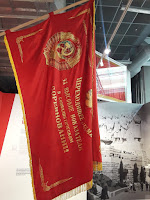 |
| Charles Bridge clock tower at night |
 |
| Czechs believe their buildings should be elaborately decorated |
The next morning, we had a walking tour of Prague that started with a tram ride across town and up the hill to the picturesque Prague Castle that looms over the city.
 |
| the middle window in the lower row |

 Katie wrote about the St. Vitus Cathedral that is within the Prague Castle: This is the most important and largest church in Prague. It was started in the tenth century and was not completed for another 600 years! It is central to the religious and cultural life of the Czech Republic, because it is the burial place of the former Czech kings, the storage place for the Czech Crown jewels, and it holds other treasures and religious relics. The cathedral looks impressively Gothic and Baroque in its structure. It has impressive glass depicting biblical scenes and flooded with colors from stained glass. It also has carved wooden doors decorated with reliefs of Bohemian Saints. It is one of the most beautiful cathedrals still standing in Prague!
Katie wrote about the St. Vitus Cathedral that is within the Prague Castle: This is the most important and largest church in Prague. It was started in the tenth century and was not completed for another 600 years! It is central to the religious and cultural life of the Czech Republic, because it is the burial place of the former Czech kings, the storage place for the Czech Crown jewels, and it holds other treasures and religious relics. The cathedral looks impressively Gothic and Baroque in its structure. It has impressive glass depicting biblical scenes and flooded with colors from stained glass. It also has carved wooden doors decorated with reliefs of Bohemian Saints. It is one of the most beautiful cathedrals still standing in Prague!We walked from the castle down to the river that flows through Prague. There are several bridges linking the two sides of the river.
Here is Katie’s description:
The Vltava River is the longest river within the Czech Republic, running southeast along the Bohemian forest. It is commonly referred to as the "Czech national river." During the day, there are many cruise boats that can be rented for exploration; there are people kayaking, others fishing, ducks swimming, and some fish jumping in the water. (On our free day in Prague, a few students rented paddled boats and explored it.) There is also a lovely little island, located near the bank of the small quarter on the Vltava river where you can relax and watch life as it happens on the famous Charles Bridge.
 |
| religious statue on the Charles Bridge |
Sam Ceja and Sydney describe some of the history of Czechoslovakia and the Czech Republic: Originally Czechoslovakia was created in the dissolution of Austria-Hungary after World War I in 1917, in the “Pittsburgh Agreement.” Tomáš Garrigue Masaryk and other Czech and Slovak representatives were part of this agreement, and they promised a common state consisting of two equal nations, Slovaks and Czechs.
Sydney reports about the division and dissolution of Czechoslovakia under Nazi German rule. The Munich pact was a settlement permitting Nazi annexation of portions of Czechoslovakia along the southern and eastern portion of Germany’s borders. It was signed by the British and French prime ministers, and Hitler. The British and French thought this would satisfy Hitler’s desire for land – but others say they knew it would not, and it was just a way to “buy time” and prepare for an inevitable war. War came for the Czechs on March 15, 1939 when the Nazis invaded the part of Czechoslovakia that had not been absorbed earlier. The Germans began to enforce their special policies toward Jews. Jews were considered inferior, were forced to live segregated into ghettos, had to wear identifying badges, and were extremely restricted.
 |
| Soviet army liberated Prague from Germans- here is a banner |
In the Old City, next to the national museum, there was a historical display of the different phases of Czech history. Like the Poles, the Czechs staged a revolt against the departing German army – they hated the Nazi regime, and they wanted to show the Soviets that they deserved independence. Unlike the Poles, the Czechs were not bombarded by the Germans. But like the Poles, they did not retain independence. Sam C reports that the Soviet Union occupied Czechoslovakia and reunified the territory as the third Czechoslovak republic.
 |
| Wenceslaus statue in Prague town square, gathering place for protests |
Sam C reports on the “Velvet Divorce” of 1989. It was named this because of the virtually non-violent end of communism, and—in 1993—the dissolution of Czechoslovakia into the Czech Republic and Slovakia. All Czechoslovak citizens automatically became citizens either of the Czech Republic or the Slovak Republic, based on their previous citizenship, permanent residence address, birthplace, pedigree, or occupation. Once both countries signed the Schengen Agreement (part of the EU), they no longer even needed passports or anything official to cross the border.
Slovakia has higher political stability than the Czech Republic: as of 2018, Slovaks have had only four prime ministers since 1998, while the Czechs have had ten. Slovaks have become a more integral part of the EU thanks to their adoption of the euro. In the Czech Republic, the right wing has been regarded as the key to economic growth. We kept hearing snide comments about the current government.
We had a free afternoon and broke up into smaller groups for different activities.



No comments:
Post a Comment